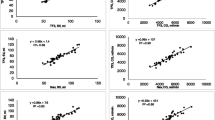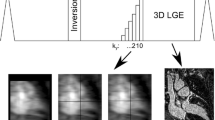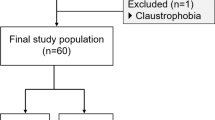Abstract
To evaluate the effect of MRI blood pool contrast agent on 4D flow image quality and ventricular volume measurements. Adult patients referred for clinical cardiac MRI (n = 22) were imaged with 4D flow. Patients with renal failure (n = 10) received ferumoxytol, and the remainder (n = 12) received gadofosveset trisodium. Image quality was assessed with (1) signal-to-noise ratio (SNR); (2) contrast-to-noise ratio (CNR); and (3) 5-point Likert scale based on endocardial border definition (1 = none; 2 = partial but unable to visualize; 3 = able to roughly estimate; 4 = visible for most of the cardiac cycle; 5 = excellent definition). A subset (n = 15) had short axis steady-state free precession (SSFP) cine imaging allowing for comparison of standard volumetric measurement technique with 4D flow derived volumetric measurements. 4D flow studies using ferumoxytol demonstrated a higher median Likert score of 5 (IQR, 5–5) versus 3 (IQR, 2–3). Median cavity SNR and CNR were higher for ferumoxytol compared to gadofosveset trisodium [65 (IQR, 50–74) versus 22 (IQR, 14–28), p < 0.001; and 40 (IQR, 32–49) versus 4 (IQR, 3–10), p < 0.001]. Good correlation (p < 0.001) was seen between SSFP and 4D flow measured ventricular volumes (ESV and EDV) with ferumoxytol (r = 0.998, mean difference = 1.2 mL, LOA = − 7.7–10.1 mL) and gadofosveset trisodium (r = 0.942, mean difference = − 2.7 mL, LOA = − 35.7–27.1 mL). Ferumoxytol used off-label as an MRI blood pool contrast agent offers an attractive alternative to gadofosveset trisodium in patients with renal failure, with excellent 4D flow image quality and good correlation of volumetric measurements compared to the CMR reference (SSFP).



Similar content being viewed by others
Abbreviations
- CNR:
-
Contrast to noise ratio
- EDV:
-
End diastolic volume
- ESV:
-
End systolic volume
- FDA:
-
US Food and Drug Administration
- IQR:
-
Inter-quartile range
- LV:
-
Left ventricle
- MRA:
-
Magnetic resonance angiography
- MRI:
-
Magnetic resonance imaging
- RV:
-
Right ventricle
- SNR:
-
Signal-to-noise ratio
- TE:
-
Echo time
- TR:
-
Repetition time
- VENC:
-
Velocity encoding range
- 4D flow:
-
Three-dimensional, time-resolved phase contrast MRI
References
Prince MR (2003) A pilot investigation of new superparamagnetic iron oxide (ferumoxytol) as a contrast agent for cardiovascular MRI. J X-Ray Sci Technol 11(4):231–240
Stillman AE, Wilke N, Jerosch-Herold M (1997) Use of an intravascular T1 contrast agent to improve MR cine myocardial-blood pool definition in man. J Magn Reson Imag 7(4):765–767
Finn JP, Nguyen KL, Han F et al (2016) Cardiovascular MRI with ferumoxytol. Clin Radiol 71(8):796–806
Vasanawala SS, Nguyen KL, Hope MD et al (2016) Safety and technique of ferumoxytol administration for MRI. Magn Reson Med 75(5):2107–2111
Hope MD, Hope TA, Zhu C et al (2015) Vascular imaging with ferumoxytol as a contrast agent. AJR Am J Roentgenol 205(3):W366-73
Bremerich J, Bilecen D, Reimer P (2007) MR angiography with blood pool contrast agents. Eur Radiol 17(12):3017–3024
Bashir MR, Bhatti L, Marin D et al (2015) Emerging applications for ferumoxytol as a contrast agent in MRI. J Magn Reson Imag 41(4):884–898
Bock J, Frydrychowicz A, Stalder AF et al (2010) 4D phase contrast MRI at 3 T: effect of standard and blood-pool contrast agents on SNR, PC-MRA, and blood flow visualization. Magn Reson Med 63(2):330–338
Hsiao A, Lustig M, Alley MT et al (2012) Rapid pediatric cardiac assessment of flow and ventricular volume with compressed sensing parallel imaging volumetric cine phase-contrast MRI. AJR Am J Roentgenol 198(3):W250–W259
Hanneman K, Kino A, Cheng JY et al (2016) Assessment of the precision and reproducibility of ventricular volume, function, and mass measurements with ferumoxytol-enhanced 4D flow MRI. J Magn Reson Imag 44:383–392
Chelu RG, van den Bosch AE, van Kranenburg M et al (2016) Qualitative grading of aortic regurgitation: a pilot study comparing CMR 4D flow and echocardiography. Int J Cardiovasc Imaging 32(2):301–307
Kawel-Boehm N, Maceira A, Valsangiacomo-Buechel ER et al (2015) Normal values for cardiovascular magnetic resonance in adults and children. J Cardiovasc Magn Reson 17:29
Bland JM, Altman DG (1999) Measuring agreement in method comparison studies. Stat Methods Med Res 8(2):135–160
European Medicines Agency (2017) PRAC concludes assessment of gadolinium agents used in body scans and recommends regulatory actions, including suspension for some marketing authorisations. Review finds evidence of gadolinium deposits in the brain after MRI body scans but no signs of harm. EMA/157486/2017
Ramalho J, Semelka RC, Ramalho M et al (2016) Gadolinium-based contrast agent accumulation and toxicity: an update. AJNR Am J Neuroradiol 37(7):1192–1198
Laurent S, Forge D, Port M et al (2008) Magnetic iron oxide nanoparticles: synthesis, stabilization, vectorization, physicochemical characterizations, and biological applications. Chem Rev 108(6):2064–2110
Camren GP, Wilson GJ, Bamra VR et al. (2014) A comparison between gadofosveset trisodium and gadobenate dimeglumine for steady state MRA of the thoracic vasculature. Biomed Res Int, 2014:625614
Lai LM, Cheng JY, Alley MT, Zhang T, Lustig M, Vasanawala SS (2017) Feasibility of ferumoxytol-enhanced neonatal and young infant cardiac MRI without general anesthesia. J Magn Reson Imaging 45(5):1407–1418
Acknowledgements
The authors would like to thank Christopher B. Williams (technologist) and Benjamin Mow (chief technologist) for their technical guidance and support.
Funding
Supported by NIH/NHLBI R01 HL123759 and the UCSF Department of Radiology & Biomedical Imaging Seed Grant.
Author information
Authors and Affiliations
Corresponding author
Ethics declarations
Conflict of interest
All authors have nothing to disclose.
Rights and permissions
About this article
Cite this article
Mukai, K., Burris, N.S., Mahadevan, V.S. et al. 4D flow image quality with blood pool contrast: a comparison of gadofosveset trisodium and ferumoxytol. Int J Cardiovasc Imaging 34, 273–279 (2018). https://doi.org/10.1007/s10554-017-1224-x
Received:
Accepted:
Published:
Issue Date:
DOI: https://doi.org/10.1007/s10554-017-1224-x




